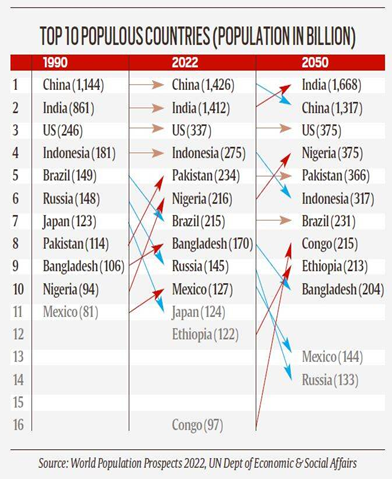UN Population Report
-
Context
UN’s Population Division has released 2022 edition of World Population Prospects on World Population Day, i.e., on 11July.
-
Background
- Demographics refer to statistical data relating to the population of a region. This includes various factors such as population growth rate, percentage of different age groups in the population, literacy rate, sex ratio, urban-rural population ratios, etc.
- According to the 2011 census, India has a population of 1.21 billion.
- They make up 17.5% of the world's population and 2.4% of the world's land area.
- In terms of population, India is the second largest country in the world and despite the declining growth rate; India continues to be a high growth country.
- About one in six people in the world are from India. The population of India is almost equal to the total population of the USA, Indonesia, Brazil, Pakistan, Bangladesh and Japan combined.

-
Analysis
What is World Population Prospects?
- World Population Prospects (WPP) is a biennial report published by UN Population Division.
- The population division is publishing the report since 1951.
- Each revision of the report provides a historical time series of the population indicators.
- That parameter that it takes into account, includes the newly released data national data of:
- Fertility
- Mortality
- International migration

-
What are the key takeaways?
- Declining growth rate: The world population continues to grow, but the rate of the growth has been declined. In the 2020, the growth rate fell under 1% per year for the first time since 1950.
- Skewed Growth: The determining factors of the population growth rate vary from region to region, country to country. More than half of the projected increase in global population till 2050 will be concentrated in just eight countries; Republic of Congo, Egypt, Ethiopia, India, Nigeria, Pakistan, Philippines, and the United Republic of Tanzania.
Net flow of labours:
- India (-3.5 million)
- Pakistan (-16.5 million)
- Nepal (-1.6 million)
- Sri Lanka (-1.0 million)
- Syrian Arab Republic (-4.6 million)
- Venezuela (-4.8 million)
- Myanmar (-1.0 million)
- Fastest growing LDCs: 46 least developed countries are among the world’s fastest growing nations, projecting many of them doubling the population between 2022 and 2050.
- Increasing dependency Ratio: The ratio of old age population is increasing in numbers as well as in share of population. It is expected to increase from 10% in 2022 to 16% in 2050.
- Drop in fertility and demographic dividend: A sustained drop in fertility rate has led to increase in number of working age people, providing a scope to perish the demographic dividend.
- International migration: High income countries are experiencing a significant impact on population driven by international migration from low and middle income countries.
-
What does the report says on Indian population estimation?
- Most populous nation: India is projected to surpass China as the world’s most populous countries by 2023.
- Twenty billion away from plateau: India’s present population is already 1.4 billion, which is expected to cross 1.6 billion before declining.
- Replace rate of fertility: India has achieved replacement rate of fertility.
- Share of age groups: In the coming decades, age group from 0-14 and 15-24 will show a declining trend and an increasing trend in 25-65 and 65+ age group.

-
What are the potential challenges for the developing nations specially India?
- Social security: Increasing rate of dependency ratio will provide a potential threat to the social and economic security to the old aged population.
- Demographic liability: The concentrated age group of 24-65, provides a scope for double edged sword. A window for demographic dividend which needs to be perished, if not, the turning into a massive disastrous situation of demographic liability.
- Pressure on resource: 46 least developed countries are expected to double the population between 2022 to 2050, putting an additional pressure on the resource.
- Securing better quality of life: Skewedness in the growth rate towards the developing nations, will contribute to the challenge to provide a better quality of life by the developing nations.
- Poverty elimination: India with 1.4 billion in absolute terms of population may face issues in the poverty reduction policy measures.
- Health Facility: The recent health emergency had provided the mark sheet of the health infrastructure and health service facility, with a population count of 1.4 billion it will challenging for India to provide access to the health care facility to its citizens.
- Achieving SDGs: Developing countries with increasing trend of population growth will find it difficult to achieve the targets of UN’s Sustainable Development Goals.

-
What needs to be done?
- Education and skill development: To ripe the working age population and turning it into demographic dividend it is required to improve the employability of the youth with education and skill development.
- Social security measure: Government must rationalize its expenditure to provide a sustained social security to the old aged population, such as, pension schemes and universal health care system etc.
- Access to health care facility: To maximize the potential benefits of a favourable age distribution, countries need to invest in further development of human capital by ensuring access to health care.
- Employment generation: Foremost and one the important policy measures that needs to be done by the countries is to promote opportunity for productive employment and decent work.
- Sticking around families: The challenges can be reduced if the people go back to the roots and stick around as families, against the tendency of individualism.
-
Conclusion
The increase in old age aged population is growing quite fast and its faces several challenges, social security is one of the big challenge. The demographic dividend needs to be perished with skill development and education to sustain the increasing dependency ratio.

